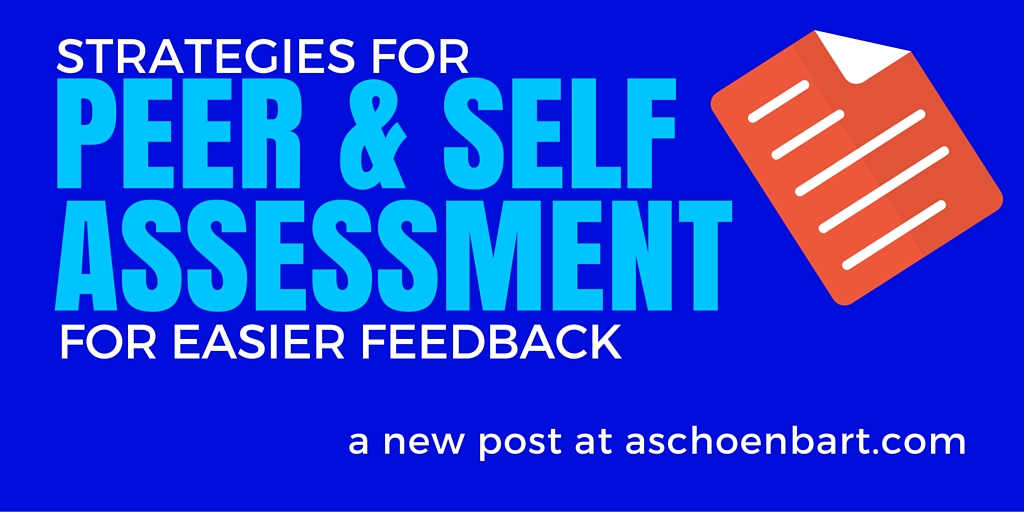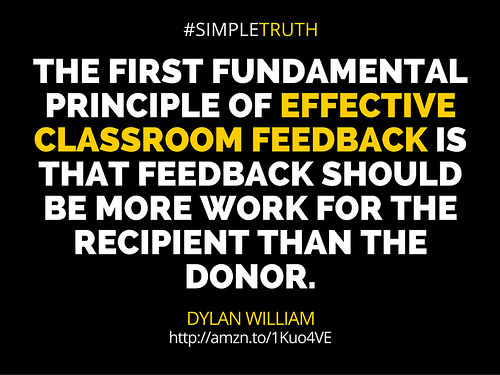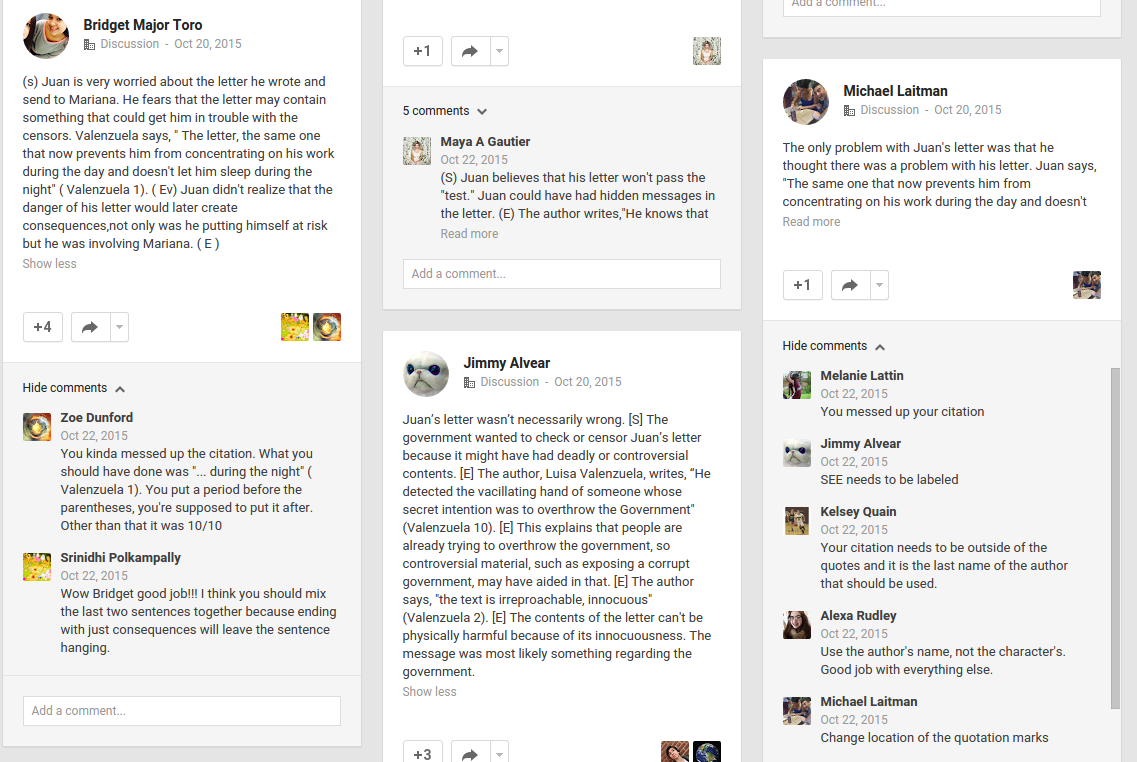Strategies for Peer & Self Assessment for Easier Feedback


Grading is hard.
It’s a truth for many educators--or has been at some point in our careers. Whether we’re looking at grading, assessment, or feedback, it’s challenging to respond effectively to student work. It’s even harder to do so consistently, in a timely manner, and without letting the work take over.
In my first few years teaching, I would have to reserve a day or two of my weekend to evaluate a few class sets of student essays. Projects, paragraphs, and any assignment that required feedback often became the focal point of my week, and too often I was looking backwards instead of forwards. I had to learn to find balance and to deliver feedback and grades more effectively so that the process takes less time and energy from me and gives more meaning to students--something I still struggle with.
I believe that grades should communicate what students know and can do, but a number or letter really does little to provide that information. Good evaluation also needs to provide meaningful feedback to help students’ understand their strengths and weaknesses and to help them progress and learn. While I’m not ready to throw out grades entirely, I’ve refocused a lot of my teaching and class time on more effective strategies for feedback to help students grow by asking students to do more.
Image from Bill Ferriter’s The Tempered Radical

5 Strategies for Peer and Self Assessment
Let’s help students grow by shifting the emphasis from the teacher to the learner in providing feedback. Through peer and self assessment, with a variety of tools and scaffolds, teachers can help students better understand learning tasks and assessments, communicate more and more effective feedback, and reduce the time and stress that’s often involved in grading and assessment.
Tools and ideas to transform education. Sign up below.
1. Model, Practice, and Scaffold
All new skills take practice. Give students opportunities to practice giving constructive feedback so that they better understand what good feedback looks like. I ask students to become the teacher and to consider my comments when providing their own. We use samples from former students, mentor texts, or of my own creation to shift the emphasis off critiquing current student work and objectively analyzing and commenting on writing.
Work with students to develop norms for effective feedback. What is constructive criticism? How many comments are appropriate? Should there be a balance of global and local comments? What are students looking for--grammar and writing? Big ideas? Provide students with scaffolding, a focus for feedback, and opportunities to practice interacting with and creating good feedback.
2. Collaborate and Build Community
Students do better when they write for real audiences, and when they know that their work will be read and evaluated by peers, they often are more careful and purposeful in the work. Use these opportunities to have students collaborate with partners and small groups to build trust and community. A new set of eyes will always provide a new perspective and insight on student work.
I love using online tools for this so that students can quickly and effectively write and provide feedback to one another. My classes work on Google+ Communities, where they can +1, reply to, and tag others in their work. Students can also see each other’s responses so that they have a copy of class notes, student products, and dozens of examples of effective feedback to always come back to.
For more on Google Communities, check out Sharing and Publishing Student Work on Google Communities.

3. Provide Evaluation Criteria
Give students the same evaluation criteria you will use for their peer and self assessments. If they use and understand your rubrics or guidelines before they begin to provide feedback (and even begin the task themselves), they will be able to provide more meaningful comments and evaluation.
I use Goobric and Doctopus to provide rubric-based feedback through Google Classroom. I can add the same rubric I give students with the assignment, select scores and qualities from the rubric, and then provide my own custom feedback, too. Additionally, I can add voice comments or use rubrics from the Goobric Library, which includes some Common Core and other standardized rubrics. A powerful recent addition is the ability for students to complete peer and self evaluations with Goobric, too. Find a guide to Goobric from Oli Trussellhere.
4. Provide Choice
Like with most learning, student often do better when given options for responding to work. Sometimes I will ask them to respond in a specific way to practice a new skill or isolate a specific type of activity, but often I provide a range of feedback options.
Some students like to print hard copies of their work and self-assess. Others share on Google Drive and provide comments and suggestions. One of my favorites is using a Google Form, like this one. In this form, students respond to a guided checklist of questions and then provided more open-ended feedback. With the Form Mule or Simply Send add-ons, the results can be e-mailed directly to the student for a quick and thorough response.
For more on Form Mule, check out the first episode of The Schoencast here.
5. Provide Opportunities for Growth
For students to find value in the feedback, they need to be able to apply it to future learning. Often, that involves revision in my class. Other times, students reflect back on past feedback as they prepare for future learning and assessment. Without a direct application towards growth, though, the feedback is often ignored or forgotten.
For years, I saw the essays that I spent hours responding to wind up buried in folders, backpacks, and garbage cans. With revisions, reflections, Google Docs comments, and Doctopus, my students interact with the feedback in much more meaningful ways. And using the technology, they are accountable and always able to return to and learn from past successes and challenges.
A Work in Progress
I love asking students to provide feedback. Often this saves me time and energy because my students’ comments are effective and meaningful. With a check, plus one, or quick piece of feedback I can validate their work, check for understanding, and ensure that they are ready to move forward. Then, I can dedicate more time to the students who really need it, both as the creators and editors.
Still, it’s important to remember that the students aren’t teachers. Many have trouble editing themselves and need a lot of help to give feedback to others. Some are uncomfortable sharing their work in the first place. All of these challenges take time, scaffolding, and persistence. With clear expectations and concrete steps, I find that almost all of my students benefit greatly from collaborative feedback. And by this point in the school year, I don’t need to give that direction anymore because it’s become a part of our class routine.
Take the ideas and strategies that work for you and adapt them to be successful for your learners. The important part is to empower students, develop stronger understandings, and to create more opportunities for progress. Work differently to make the feedback and evaluation process more effective, easier, and less time consuming so we can continue to help students grow.
What are your favorite strategies for getting students more involved in the feedback process? Share in the comments here or on Twitter.
cross posted at www.aschoenbart.com
Adam Schoenbart is a high school English teacher, Google Education Trainer, and EdD candidate in Educational Leadership. He teaches grades 10-12 in a 1:1 Chromebook classroom at Ossining High School in Westchester County, NY and received the 2014 LHRIC Teacher Pioneer Award for innovative uses of technology that change teaching and learning. Read more at The SchoenBlog and connect on Twitter @MrSchoenbart.
